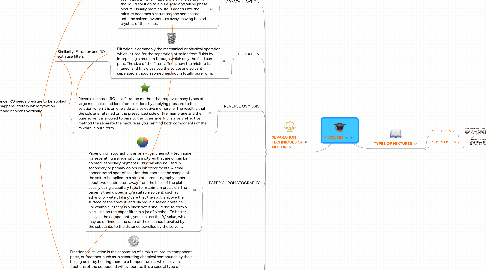
1. SEPARATION TECHNIQUES OF MIXTURES
1.1. DISTILLATION
1.1.1. Distillation is a method of separating mixtures based on differences in their volatilities in a boiling liquid mixture.This can be used to obtain a pure solvent from a mixture.
1.1.1.1. Similarity:Distillation and evaporation both use boiling.
1.1.1.2. Similarity: Distillation and fractional distillation both use distillation.
1.2. EVAPORATION
1.2.1. Evaporation is a separation method where the solvent is heated and evaporated away to leave behind the pure solute.
1.2.1.1. Difference: Evaporation leaves the solute behind, while distillation leaves both behind, although usually only the solvent is.
1.3. CRYSTALLISATION
1.3.1. Crystallization is a chemical solid-liquid separation technique, in which mass transfer of a solute from the liquid solution to a pure solid crystalline phase occurs. Usually more solute is added until the mixture becomes a saturated one and heated until the solvent evaporates away, leaving behind crystals of the solute.
1.4. FILTRATION
1.4.1. Filtration is commonly the mechanical or physical operation which is used for the separation of solids from fluids by interposing a medium through which only the fluid can pass. The size of the filters affects how the mixture is filtered, and this gives you the solute and solvent separated,although sometimes not in totally pure form.
1.4.1.1. Similarity: Filtration and RO both use filters.
1.5. REVERSE OSMOSIS
1.5.1. Reverse osmosis (RO) is a filtration method that removes many types of large molecules and ions from solutions by applying pressure to the solution when it is on one side of a selective membrane. The result is that the solute is retained on the pressurized side of the membrane and the pure solvent is allowed to pass to the other side. RO is a very effective method the separate the mixture as you can find both components of the mixture in pure form.
1.5.1.1. Difference: RO needs pressure to be applied and it happens laterally while filtration doesn't and happens vertically.
1.6. PAPER CHROMATOGRAPHY
1.6.1. Paper chromatography is an analytical chemistry technique for separating and identifying mixtures that are or can be colored, especially pigments. This can also be used in secondary or primary colors in ink experiments. A small concentrated spot of solution that contains the sample of the solute is applied to a strip of chromatography paper about two centimeters away from the base of the plate, usually using a capillary tube for maximum precision. The paper is then dipped into a suitable solvent, such as ethanol or water, taking care that the spot is above the surface of the solvent, and placed in a sealed container. For example if there is a black dot it should rise to form a black line on the paper filter in a jar of alcohol. To better analyse the components, you can use the Rƒ value, which may be defined as the ratio of the distance travelled by the substance to the distance travelled by the solvent.
1.7. FRACTIONAL DISTILLATION
1.7.1. Fractional distillation is the separation of a mixture into its component parts, or fractions, such as in separating chemical compounds by their boiling point by heating them to a temperature at which several fractions of the compound will evaporate. It is a special type of distillation. Fractional distillation in a laboratory makes use of common laboratory glassware and apparatuses, typically including a Bunsen burner, a round-bottomed flask and a condenser, as well as the single-purpose fractionating column. Distillation is the most common form of separation technology used in petroleum refineries, petrochemical and chemical plants , natural gas processing and cryogenic air separation plants. In most cases, the distillation is operated at a continuous steady state. New feed is always being added to the distillation column and products are always being removed. It is an extremely useful method for separating crude oil, one of the most important industrial mixtures.
1.7.1.1. Difference: Fractional distillation separates the mixture into many different pure components, while distillation only leaves the solvent behind usually.
1.8. MAGNETIC SEPARATION
1.8.1. Magnetic separation is a process in which magnetically susceptible material is extracted from a mixture using a magnetic force. This separation technique can be useful in mining iron as it is attracted to a magnet. It only works in a mixture made out of a magnetic and non-magnetic material.
2. TYPES OF MIXTURES
2.1. SOLUTIONS
2.1.1. SIMILARITY: BOTH ARE MADE UP OF SOLIDS HELD IN LIQUIDS BUT NOT CHEMICALLY COMBINED.
2.2. SUSPENSIONS
2.2.1. DIFFERENCE:SUSPENSIONS ARE INSOLUBLE SOLIDS HELD IN THE LIQUID. SOLUTIONS ARE SOLUBLE SOLIDS HELD IN A LIQUID.
